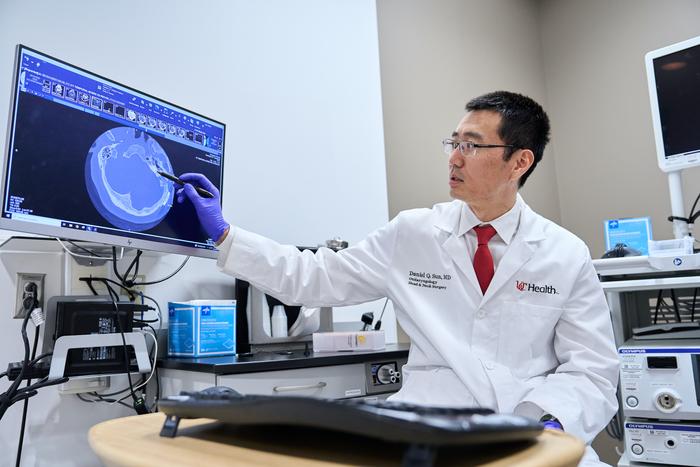Just as a business needs an effective and reliable service to deliver its goods to customers, medications need an effective delivery system to get them to the specific area of the body where they can have an impact.

Credit: Photo/UC Health
Just as a business needs an effective and reliable service to deliver its goods to customers, medications need an effective delivery system to get them to the specific area of the body where they can have an impact.
The University of Cincinnati’s Daniel Sun, MD, has received a career development award of just more than $1 million from the National Institutes of Health’s National Institute on Deafness and Other Communication Disorders to research the potential of using magnetic nanoparticles as a delivery system for drugs to reach the inner ear and treat hearing loss.
Aside from often ineffective steroids, there are currently no drugs approved by the Food and Drug Administration to treat hearing loss, and getting the medications into the inner ear, where hearing loss occurs, is a major hurdle.
“There are a lot of interesting medications that are in the pipeline that have a lot of potential to transform the way we treat hearing loss and allow us to delay or even reverse hearing loss,” said Sun, the Myles L. Pensak, MD, Endowed Professor in Neurotology and Skull Base Surgery, director of the Division of Neurotology, neurotology fellowship program director and associate professor of otolaryngology in the University of Cincinnati College of Medicine, and a UC Health physician. “But we don’t have a good way to get these promising medications into the ear very effectively.”
Magnetic nanoparticles have been used as a drug delivery system in other parts of the body, but Sun said his research is helping develop a better understanding of exactly how to engineer the nanoparticles specifically for the ear’s anatomy.
“The goal is to create something that’s minimally invasive and then use a magnetic field to steer these nanoparticles into the ear where hearing loss is happening,” Sun said.
Different kinds of hearing loss, like age-related hearing loss, noise trauma and sudden hearing loss, are caused by different mechanisms and therefore treated by different medications. If magnetic nanoparticles are effective, they could act as the delivery truck that gets loaded up with the specific medication each patient needs based on their kind of hearing loss.
“Based on the way they’re engineered, these particles can carry many different forms of medications,” Sun said. “It’s essential that we can use a common platform for different medications that can target different types of hearing loss.”
In addition to the magnetic field research, Sun and Donglu Shi, PhD, from UC’s Department of Mechanical and Materials Engineering, are collaborating to study the effectiveness of lasers to activate the nanoparticles and help them penetrate the inner ear.
“We want to approach it very systematically and rigorously to truly understand how to design these nanoparticles in a way that is biocompatible, that is safe for hearing and balance function in the ear,” Sun said. “At the same time, we want to provide very robust drug delivery capabilities. We’re really starting from the ground up to understand how these particles really penetrate the membrane that separates our middle ear from the inner ear and how these particles actually go to the areas of the inner ear that we need them to go to.”
Long term, Sun said a breakthrough in drug delivery combined with the new medications being developed could open a new world for noninvasive treatment of hearing loss.
“We really want to look to a future where people, regardless of age or their health, can safely undergo these treatments with these promising medications in a way that is minimally invasive and also effective in treating their hearing loss,” he said.
Sun was initially awarded this grant while at Johns Hopkins University and transferred the grant when he joined the faculty at UC.



